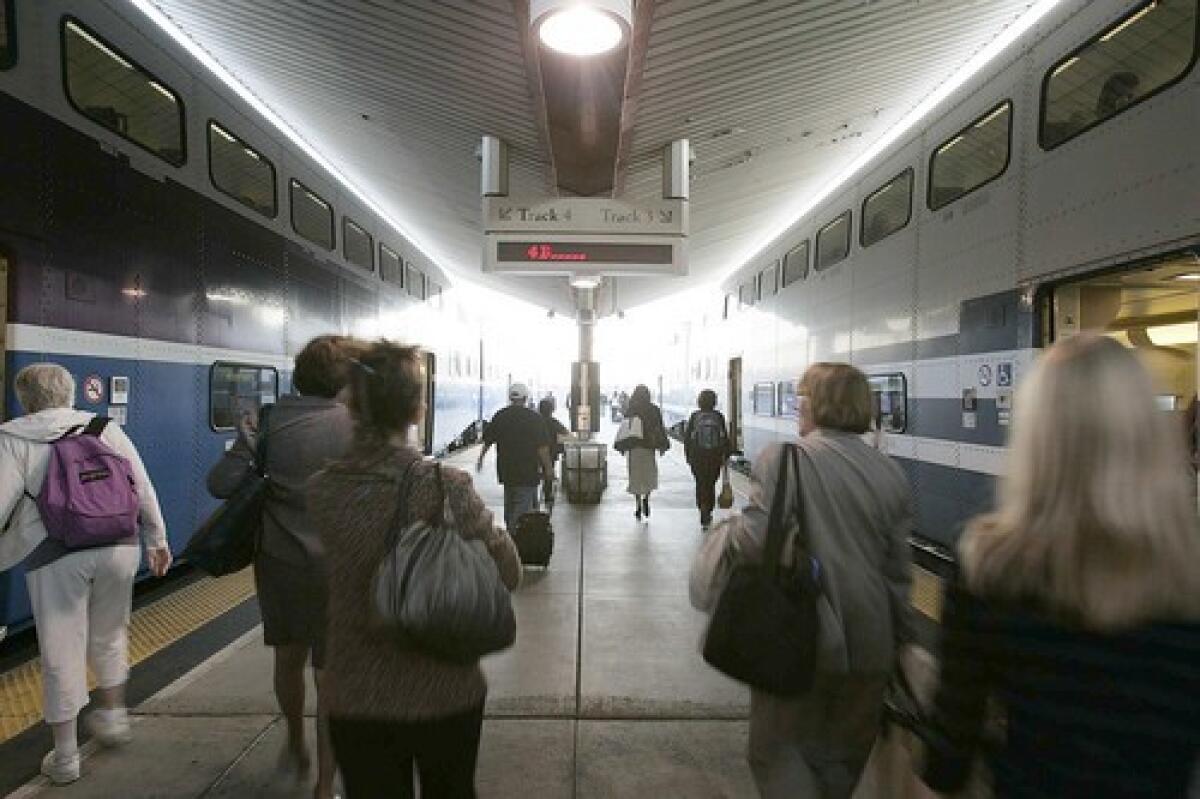Metrolink board lacks firsthand passenger experience

- Share via
About seven to 10 times each month, Art Brown hops on a Metrolink train.
As a member of the commuter rail’s five-county governing board, he usually carries a bag imprinted with the word “Metrolink.” Brown says he does it to attract comments from other riders on the regional service.
“It was mostly service-oriented,” said Brown, an appointed member whose primary public office is mayor pro tem of Buena Park and who serves on other transit boards. “ ‘When are we going to add more cars, when are we going to have a bar car?’ They want more trains and they want them to run later.”
That Brown takes the train as often as he does makes him unique among the 11 voting members of the Metrolink board. The rest only ride occasionally and some live miles from the nearest station. None is an everyday rider.
In September, Metrolink experienced the deadliest crash in its 16-year history. A train filled with commuters failed to stop at a warning light and collided head-on with a Union Pacific freight train. Twenty-five people died and 135 were injured.
In recent days, some Metrolink passengers interviewed by The Times questioned whether board members who use the line so infrequently can fully appreciate the concerns that daily riders have about operations and safety.
“You would hope that people who are encouraging something like this are actually investing time in it,” said PJ Woolston, who takes Metrolink from Burbank to downtown Los Angeles and praises the service.
Board members in business and government are usually expected to concentrate only on setting broad policy. But some advocates say overseeing transit agencies is different because of the effect they have on thousands of people and their need to be appealing, safe and fast to compete with cars.
And unlike some other transit boards in California, Metrolink -- carrying about 47,000 passengers each weekday -- has no slots reserved for people who directly represent riders or the public at large.
“To be fair, the role of a transit agency board isn’t to nitpick daily operations. They’re supposed to be focusing on the bigger picture,” said Margaret Okuzumi, executive director of BayRail Alliance, a transit advocacy group in Northern California. “The problem is if they’re not familiar with the day-to-day experience, it’s hard for them to relate to what kind of conditions would better serve their riders.”
Even when Brown led the Metrolink board, he said, he found it hard to get colleagues to directly experience the service they provided.
“When I became chairman . . . I wanted members to go ride the train and go to the facilities to see how Metrolink works,” Brown said.
Metrolink board members serve on a part-time basis and are paid $100 for each meeting they attend. Most are politicians appointed by transit agencies in the counties where they live.
Two of the most prominent members -- Los Angeles County Supervisors Mike Antonovich and Don Knabe -- have aides who ride the commuter rails and report back as surrogates of a sort. Both men usually drive to work, Antonovich from Glendale and Knabe from Cerritos.
“Don is the only member of the board that drives a hybrid,” said David Sommers, a Knabe spokesman, adding that several people in Knabe’s office take mass transit.
“I grew up on public transit,” Antonovich said in an interview, and he pointed to his days riding the old S streetcar line in South Los Angeles, where his family lived.
Nowadays it’s a different matter, he said. “If I worked in a stationary workplace and I had a normal schedule, I could take public transportation there and back.” The problem is that he must travel throughout his far-flung district, which covers much of northern Los Angeles County. Antonovich added that he gets input from staffers who ride Metrolink and other transit services.
Other board members said they feel sufficiently informed about Metrolink, either by reports from Metrolink’s full-time staff or from their own experiences.
San Bernardino Mayor Patrick Morris, for example, was a brakeman for the Santa Fe Railroad while working his way through college, and both his father and grandfather worked for the railroad.
Other board members had eye-opening experiences when they did find time to go for a ride. Richard Dixon said that several years ago, he was in the cab of a Metrolink train as it hurtled toward a big rig stopped at a street crossing. The truck moved just in time.
“I asked the engineer, ‘If the truck was still there, would we have hit it?’ And he said, ‘We would have hit it,’ ” recalled Dixon, a Lake Forest city councilman who serves on the boards of three other transit-related or planning agencies. “I asked how often it happens and he said, ‘More often than I like.’ ”
Some California transit agencies take steps to ensure that their boards include regular riders. The transit agency for San Mateo County, for example, is seeking two public members. And the Orange County Transportation Authority reserves two of its board seats for members of the public. One is occupied by Gregory Winterbottom, who uses a wheelchair and has pushed the agency to improve facilities for disabled riders, said OCTA spokesman Ted Nguyen.
Although the Foothill Transit board consists entirely of politicians from the San Gabriel Valley, its president, Peggy Delach, a member of the Covina City Council, rides the bus every day between Covina and her downtown Los Angeles job.
She said she thinks it would be helpful if board members could ride the bus once every couple of weeks or once a month.
In 2001, former Los Angeles Mayor James K. Hahn appointed Allison Yoh to the Metropolitan Transportation Authority board, fulfilling a campaign promise to allow an actual transit rider to serve.
Yoh, now the assistant director for UCLA’s Institute of Transportation Studies, said that having politicians oversee transit agencies isn’t necessarily bad. Politicians and their staffs have institutional memory and the clout needed to run and finance big organizations.
But, Yoh said, many of the board members who didn’t ride tended to veer toward big capital investments instead of smaller fixes to make transit more appealing.
“A lot of board members would say you could get from point A to point B using transit,” Yoh said. “What they didn’t understand is that you needed to transfer two or three times,” resulting in long commutes.
Kristine Cleary rides the train every workday between Irvine and downtown Los Angeles, where she owns a clothing firm. She’s been making the trip since the mid-1980s, first on Amtrak and then on Metrolink after it was created in 1992.
The latest Metrolink crash has left her with questions about who is minding the store. “You shouldn’t have to worry about what car you’re sitting in when taking mass transit in Southern California,” said Clearly, noting that she and other passengers often try not to sit in the lead car of the train in case of a crash.
“There is a complete disconnect between what the riders are experiencing versus what the decision-makers are experiencing.”
Hymon is a Times staff writer.
More to Read
Sign up for Essential California
The most important California stories and recommendations in your inbox every morning.
You may occasionally receive promotional content from the Los Angeles Times.










